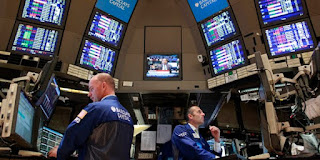William D. Cohan--the author of House of Cards: A Tale of Hubris and Wretched Excess on Wall Street (2007) and Money and Power: How Goldman Sachs Came to Rule the World--has an insightful article in The Atlantic that investigates the increasing role of computer modeling by quants in the financial markets. The ubiquitous use of technology and complex algorithmic modeling--which are often executed by computers themselves--to beat the market brings a number of socio-logically interesting questions to mind: 1) are computer driven models more likely to experience large swings; 2) are computer driven models more likely to exhibit social contagion and cause negative effects for the larger society; 3) can this technology be regulated by the State; and 4) can technology be guided so as to benefit capital allocation throughout the market, and the broader society.
The Atlantic--With the winter's second blizzard raging outside, Cliff Asness sat in his relatively modest office in Greenwich, Connecticut, surrounded by three of his partners, his PR guru, an impressive collection of unread books, and a sea of foot-tall hard-plastic replicas of Spiderman, the Incredible Hulk, and friends. "Let me be technical," he said. "It all sucked."
Asness--intense, bald, and bearded, with a $500 million fortune and a doctorate in finance--was reflecting on the dark days of 2008, when capitalism seemed to be imploding, when Bear Stearns and Lehman Brothers had collapsed and the government had hastily arranged bailouts of Merrill Lynch, Morgan Stanley, Goldman Sachs, and AIG, among others.
His own business, Applied Quantitative Research--one of the world's leading quantitative-investment, or "quant," funds--had also suffered painfully. The money his team managed fell to $17.2 billion in March 2009, from a peak of $39.1 billion in September 2007, as clients headed for the exits with what was left of their cash. Such losses can be fatal for fund managers like AQR, since sophisticated investors pay them big fees for exceptional performance and, understandably, have little patience for anything less. As AQR's founders felt the tremors from Wall Street rippling through their offices, Asness said, "we worried about the stability of the financial sector, the stability of the economy, and the stability of society." To Bloomberg Markets magazine, last fall, he was even more explicit: "I heard the Valkyries circling. I saw the Grim Reaper at my door."
Yet they survived. And AQR--which makes its fortune, like other quants, by using high-speed computers and financial models of extraordinary complexity--has made a stupendous recovery in the past two years. At the end of 2010, AQR had $33 billion in assets under management. Its funds' performance was up nearly 20 percent last year, after being up 38 percent in 2009.
This is all the more striking because many analysts believe the quants helped cause, or at least exacerbated, the meltdown by giving traders a false sense of security. The risk-control models these firms pioneered encouraged Wall Street to take on excessive leverage. Their trading strategies, which deliver excellent returns in normal times, functioned poorly in the irrationality of a financial panic, and reinforced a frenzy of selling. Although predictions of the death of AQR and its ilk, by the writer and investor Nassim Taleb, among others, turned out to have been greatly exaggerated, worries linger, even as some high-profile quants have surged back. Taleb and the other critics think their overreliance on computers gives quants excessive confidence and blinds them to the possibility of seemingly rare economic catastrophes--which seem to be not so rare these days. (This was the theme of Taleb's best-selling book, The Black Swan, which examined the effect of the "highly
improbable" on markets, and on life.) As Exhibit A, they point to the extraordinary events of May 6, 2010, when the Dow dropped by nearly 1,000 points in a few minutes after an algorithmic program executed by the investment firm Waddell & Reed, in Kansas, triggered a terrifying blitz of automated buying and selling by other financial computers. The market quickly recovered, but many worry that the episode was a preview of greater turbulence ahead as machines gain control of more and more trading.
Scott Patterson, a former Wall Street Journal reporter and the author of the 2010 book The Quants, told me he can envision a world, not too far away, in which artificial intelligence could vanquish human trading altogether, just as it has Garry Kasparov on the chessboard. "I'm not totally against quants at all, because I think they are a very powerful way of investing," Patterson said. But, like a number of other critics, he thinks they might encourage a cycle of booms and busts, and possibly intensify the next crisis. "Go to a trading room, it's just guys on computers," he said. "And a lot of times it's not even guys, it's just the computer running the machine. I don't want to demonize it. I think there has to be a happy medium. But I'm personally worried that it can run off the rails."
As much as anyone else, Cliff Asness has shaped and
embodied this world of automated high finance. And though his experience--from academia to Wall Street to Greenwich--has been marked by recurring crises, and though he admits that no one can predict when the next big one will hit, he's more confident than ever in the power of data and mathematical models, in his hands, to beat the market consistently over the long term. And, once again, the data are telling him he's right. (read more)

No comments:
Post a Comment